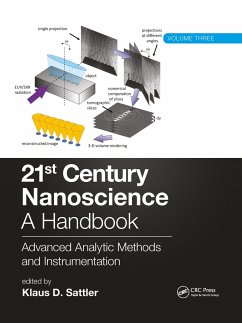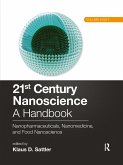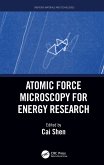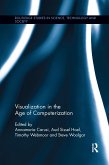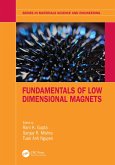21st Century Nanoscience - A Handbook
Advanced Analytic Methods and Instrumentation (Volume 3)
Herausgeber: Sattler, Klaus D.
21st Century Nanoscience - A Handbook
Advanced Analytic Methods and Instrumentation (Volume 3)
Herausgeber: Sattler, Klaus D.
- Broschiertes Buch
- Merkliste
- Auf die Merkliste
- Bewerten Bewerten
- Teilen
- Produkt teilen
- Produkterinnerung
- Produkterinnerung
This up-to-date reference is the most comprehensive summary of the field of nanoscience and its applications. It begins with fundamental properties at the nanoscale and then goes well beyond into the practical aspects of the design, synthesis, and use of nanomaterials in various industries.
Andere Kunden interessierten sich auch für
![21st Century Nanoscience - A Handbook 21st Century Nanoscience - A Handbook]() 21st Century Nanoscience - A Handbook69,99 €
21st Century Nanoscience - A Handbook69,99 €![Atomic Force Microscopy for Energy Research Atomic Force Microscopy for Energy Research]() Atomic Force Microscopy for Energy Research216,99 €
Atomic Force Microscopy for Energy Research216,99 €![Solid State Chemistry Solid State Chemistry]() Elaine A. Moore (The Open University, Milton Keynes, UK)Solid State Chemistry55,99 €
Elaine A. Moore (The Open University, Milton Keynes, UK)Solid State Chemistry55,99 €![Policing Domestic Abuse Policing Domestic Abuse]() Katy Barrow-GrintPolicing Domestic Abuse175,99 €
Katy Barrow-GrintPolicing Domestic Abuse175,99 €![Policing Domestic Abuse Policing Domestic Abuse]() Katy Barrow-GrintPolicing Domestic Abuse72,99 €
Katy Barrow-GrintPolicing Domestic Abuse72,99 €![Visualization in the Age of Computerization Visualization in the Age of Computerization]() Visualization in the Age of Computerization35,99 €
Visualization in the Age of Computerization35,99 €![Fundamentals of Low Dimensional Magnets Fundamentals of Low Dimensional Magnets]() Fundamentals of Low Dimensional Magnets142,99 €
Fundamentals of Low Dimensional Magnets142,99 €-
-
-
This up-to-date reference is the most comprehensive summary of the field of nanoscience and its applications. It begins with fundamental properties at the nanoscale and then goes well beyond into the practical aspects of the design, synthesis, and use of nanomaterials in various industries.
Hinweis: Dieser Artikel kann nur an eine deutsche Lieferadresse ausgeliefert werden.
Hinweis: Dieser Artikel kann nur an eine deutsche Lieferadresse ausgeliefert werden.
Produktdetails
- Produktdetails
- 21st Century Nanoscience
- Verlag: Taylor & Francis Ltd
- Seitenzahl: 452
- Erscheinungstermin: 13. Juni 2022
- Englisch
- Abmessung: 211mm x 281mm x 28mm
- Gewicht: 1106g
- ISBN-13: 9781032336497
- ISBN-10: 1032336498
- Artikelnr.: 67517090
- 21st Century Nanoscience
- Verlag: Taylor & Francis Ltd
- Seitenzahl: 452
- Erscheinungstermin: 13. Juni 2022
- Englisch
- Abmessung: 211mm x 281mm x 28mm
- Gewicht: 1106g
- ISBN-13: 9781032336497
- ISBN-10: 1032336498
- Artikelnr.: 67517090
Klaus D. Sattler pursued his undergraduate and master's courses at the University of Karlsruhe in Germany. He received his PhD under the guidance of Professors G. Busch and H.C. Siegmann at the Swiss Federal Institute of Technology (ETH) in Zurich. He was at the University of California, Berkeley, for three years as a Heisenberg fellow, where he initiated the first studies of atomic clusters on surfaces with a scanning tunneling microscope. Dr. Sattler accepted a position as professor of physics at the University of Hawaii, Honolulu, in 1988. In 1994, his group produced the first carbon nanocones. His current work focuses on novel nanomaterials and solar photocatalysis with nanoparticles for the purification of water. He is the editor of the sister references, Carbon Nanomaterials Sourcebook (2016) and Silicon Nanomaterials Sourcebook (2017), as well as Fundamentals of Picoscience (2014). Among his many other accomplishments, Dr. Sattler was awarded the prestigious Walter Schottky Prize from the German Physical Society in 1983. At the University of Hawaii, he teaches courses in general physics, solid state physics, and quantum mechanics.
1. High-Temperature Scanning Probe Microscopy 2. Low Temperature
Investigation of Magnetic Molecules by Scanning Probe Microscopie 3.
Ultrafast Optical Pump-Probe Scanning Probe Microscopy/Spectroscopy 4.
Triggering Chemical Reactions by Scanning Tunneling Microscopy 5. The
Circular Mode AFM: A New Experimental Approach for Investigating
Nanotribology 6. Chemical Imaging with Fluorescent Nanosensors 7.
Nanometer-Scale and Low-Density Imaging with Extreme Ultraviolet and Soft
X-Ray Radiation 8. X-Ray Imaging of Single Nanoparticles and Nanostructures
9. Helium Ion Microscopy 10. Nanofiber Characterization by Raman Scanning
Microscopy 11. Quantification of Nanostructure Orientation via Image
Processing 12.Chemometrics and Super-Resolution at the Service of
Nanoscience: Aerosols Characterization in Hyperspectral Raman Imaging 13.
Atomic Force Microscope Nanoscale Mechanical Mapping 14. Electron
Holography for Mapping Electric Fields and Charge 15. Terahertz
Spectroscopy for Nanomaterial Characterization 16. TXRF Spectrometry in
Conditions of Planar X-Ray Waveguide-Resonator Application 17. Nanoscale
XPEEM Spectromicroscopy 18. Integrating Cavities and Ring-Down Spectroscopy
19.Inductively Coupled Plasma Mass Spectrometry for Nanomaterial Analysis
20. Determination of Nanomaterial Electronic Structure via
Variable-Temperature Variable-Field Magnetic Circular Photoluminescence
(VTVH-MCPL) Spectroscopy 21. Photoluminescence Spectroscopy of Single
Semiconductor Quantum Dots 22. Scanning Electrochemical Microscopy and its
Potential in Nanomaterial Characterization 23. Nanostructured Materials
Obtained by Electrochemical Methods: From Fabrication to Application in
Sensing, Energy Conversion and Storage 24. New Trends in Nanoscale
Electrodes and Electrochemistry: The Role of Dimensionality
Investigation of Magnetic Molecules by Scanning Probe Microscopie 3.
Ultrafast Optical Pump-Probe Scanning Probe Microscopy/Spectroscopy 4.
Triggering Chemical Reactions by Scanning Tunneling Microscopy 5. The
Circular Mode AFM: A New Experimental Approach for Investigating
Nanotribology 6. Chemical Imaging with Fluorescent Nanosensors 7.
Nanometer-Scale and Low-Density Imaging with Extreme Ultraviolet and Soft
X-Ray Radiation 8. X-Ray Imaging of Single Nanoparticles and Nanostructures
9. Helium Ion Microscopy 10. Nanofiber Characterization by Raman Scanning
Microscopy 11. Quantification of Nanostructure Orientation via Image
Processing 12.Chemometrics and Super-Resolution at the Service of
Nanoscience: Aerosols Characterization in Hyperspectral Raman Imaging 13.
Atomic Force Microscope Nanoscale Mechanical Mapping 14. Electron
Holography for Mapping Electric Fields and Charge 15. Terahertz
Spectroscopy for Nanomaterial Characterization 16. TXRF Spectrometry in
Conditions of Planar X-Ray Waveguide-Resonator Application 17. Nanoscale
XPEEM Spectromicroscopy 18. Integrating Cavities and Ring-Down Spectroscopy
19.Inductively Coupled Plasma Mass Spectrometry for Nanomaterial Analysis
20. Determination of Nanomaterial Electronic Structure via
Variable-Temperature Variable-Field Magnetic Circular Photoluminescence
(VTVH-MCPL) Spectroscopy 21. Photoluminescence Spectroscopy of Single
Semiconductor Quantum Dots 22. Scanning Electrochemical Microscopy and its
Potential in Nanomaterial Characterization 23. Nanostructured Materials
Obtained by Electrochemical Methods: From Fabrication to Application in
Sensing, Energy Conversion and Storage 24. New Trends in Nanoscale
Electrodes and Electrochemistry: The Role of Dimensionality
1. High-Temperature Scanning Probe Microscopy 2. Low Temperature
Investigation of Magnetic Molecules by Scanning Probe Microscopie 3.
Ultrafast Optical Pump-Probe Scanning Probe Microscopy/Spectroscopy 4.
Triggering Chemical Reactions by Scanning Tunneling Microscopy 5. The
Circular Mode AFM: A New Experimental Approach for Investigating
Nanotribology 6. Chemical Imaging with Fluorescent Nanosensors 7.
Nanometer-Scale and Low-Density Imaging with Extreme Ultraviolet and Soft
X-Ray Radiation 8. X-Ray Imaging of Single Nanoparticles and Nanostructures
9. Helium Ion Microscopy 10. Nanofiber Characterization by Raman Scanning
Microscopy 11. Quantification of Nanostructure Orientation via Image
Processing 12.Chemometrics and Super-Resolution at the Service of
Nanoscience: Aerosols Characterization in Hyperspectral Raman Imaging 13.
Atomic Force Microscope Nanoscale Mechanical Mapping 14. Electron
Holography for Mapping Electric Fields and Charge 15. Terahertz
Spectroscopy for Nanomaterial Characterization 16. TXRF Spectrometry in
Conditions of Planar X-Ray Waveguide-Resonator Application 17. Nanoscale
XPEEM Spectromicroscopy 18. Integrating Cavities and Ring-Down Spectroscopy
19.Inductively Coupled Plasma Mass Spectrometry for Nanomaterial Analysis
20. Determination of Nanomaterial Electronic Structure via
Variable-Temperature Variable-Field Magnetic Circular Photoluminescence
(VTVH-MCPL) Spectroscopy 21. Photoluminescence Spectroscopy of Single
Semiconductor Quantum Dots 22. Scanning Electrochemical Microscopy and its
Potential in Nanomaterial Characterization 23. Nanostructured Materials
Obtained by Electrochemical Methods: From Fabrication to Application in
Sensing, Energy Conversion and Storage 24. New Trends in Nanoscale
Electrodes and Electrochemistry: The Role of Dimensionality
Investigation of Magnetic Molecules by Scanning Probe Microscopie 3.
Ultrafast Optical Pump-Probe Scanning Probe Microscopy/Spectroscopy 4.
Triggering Chemical Reactions by Scanning Tunneling Microscopy 5. The
Circular Mode AFM: A New Experimental Approach for Investigating
Nanotribology 6. Chemical Imaging with Fluorescent Nanosensors 7.
Nanometer-Scale and Low-Density Imaging with Extreme Ultraviolet and Soft
X-Ray Radiation 8. X-Ray Imaging of Single Nanoparticles and Nanostructures
9. Helium Ion Microscopy 10. Nanofiber Characterization by Raman Scanning
Microscopy 11. Quantification of Nanostructure Orientation via Image
Processing 12.Chemometrics and Super-Resolution at the Service of
Nanoscience: Aerosols Characterization in Hyperspectral Raman Imaging 13.
Atomic Force Microscope Nanoscale Mechanical Mapping 14. Electron
Holography for Mapping Electric Fields and Charge 15. Terahertz
Spectroscopy for Nanomaterial Characterization 16. TXRF Spectrometry in
Conditions of Planar X-Ray Waveguide-Resonator Application 17. Nanoscale
XPEEM Spectromicroscopy 18. Integrating Cavities and Ring-Down Spectroscopy
19.Inductively Coupled Plasma Mass Spectrometry for Nanomaterial Analysis
20. Determination of Nanomaterial Electronic Structure via
Variable-Temperature Variable-Field Magnetic Circular Photoluminescence
(VTVH-MCPL) Spectroscopy 21. Photoluminescence Spectroscopy of Single
Semiconductor Quantum Dots 22. Scanning Electrochemical Microscopy and its
Potential in Nanomaterial Characterization 23. Nanostructured Materials
Obtained by Electrochemical Methods: From Fabrication to Application in
Sensing, Energy Conversion and Storage 24. New Trends in Nanoscale
Electrodes and Electrochemistry: The Role of Dimensionality
